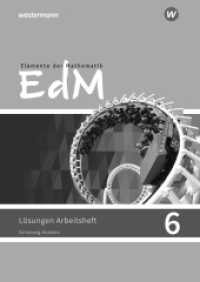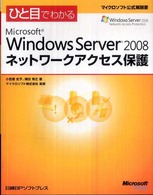- ホーム
- > 洋書
- > 英文書
- > Business / Economics
Full Description
"Organization Theory: Tension and Change" provides the most current and concise analysis of the development and evolution of organizational theories, forms, and practices, from the rise of the factory system to the emergence of the virtual global organization. Using a wide variety of examples and applications from private and public-sector organizations, the text emphasizes the tensions, contradictions, and paradoxes inherent in all organizational arrangements. In addition to the classic themes such as scientific management, human relations, rational bureaucratic models, and environmental models, the book explores emerging organizational forms based on lean and flexible production, post-bureaucracy, alliances, and networks, virtual organization and information technologies, corporate cultures, learning organizations, transnational commodity chains, and post-modernism.
Contents
ORGANIZATION THEORY: TENSION AND CHANGE1. INTRODUCTION: DEFINITIONS AND CONCEPTIONSOrganization: Elements, A Definition and ImagesW. Richard Scott's Elements of OrganizationRichard Hall's Definition of OrganizationGareth Morgan's Images of OrganizationClassical Social Theory and Organizational AnalysisKarl MarxEmile DurkheimMax Weber Contemporary Social Theory and Organizational AnalysisStructural FunctionalismConflict TheorySymbolic InteractionismSummary2. CONCEPTUAL FRAMEWORK FOR THE ANALYSIS OF ORGANIZATION THEORYLevels of Organizational Analysis and TransactionTension #1: Controlling The Human FactorOrganizational Behavior and the Human FactorMarxist Theory and the Unique Nature of LaborPhilosophical Status of the Human FactorThe Human Factor and the Reformulation of Organization Theory and Management PracticeTension #2: Differentiation and IntegrationThe Technical Division of Labor: Intraorganizational DynamicsThe Social Division of Labor: Interorganizational DynamicsA Note on Organizational Tensions and Ascribed CharacteristicsParadox: The Underlying Source of Organizational TensionModels of Organizational ParadoxThree Cases of Organizational Paradox Summary 3. THE RISE OF THE FACTORY SYSTEMIntroductionThe Formal Subordination of Labor: Creating A Human Factor of ProductionThe Real Subordination of Labor: Disciplining the Human FactorTraditional Habits and CulturesEarly Strategies and AssumptionsScientific Management in TheoryMotivation for the TheoryThe Principles and StagesAssessment and ConsequencesScientific Management in Practice: The Hoxie StudyScientific Management: The Broader ContextSummary4. THE HUMAN ORGANIZATIONThe Hawthorne Revelations and BeyondThe Hawthorne Experiments: The Human Factor ObservedInterpeting the ResultsHawthorne and the Revision of Organization TheoryRoethlisberger and DicksonElton MayoChester's World: Barnard's Theory of Organization and ManagementThe Organization and the IndividualCommon Moral PurposeHumanistic Management PracticeHuman Relations and Human NeedsFrom Human Relations to Human ResourcesLeadershipBeyond Legitimate AuthorityFour Approaches to LeadershipDoes Leadership Matter?Summary5. BUREAUCRACY, RATIONALIZATION, AND ORGANIZATION THEORYWeber and the Rational-Bureaucratic ModelWeber and the Dilemma of AuthorityBureaucratic Dysfunctions and Unintended ConsequencesRobert Merton: The Bureaucratic PersonalityAlvin Gouldner: Patterns of Industrial BureaucracyPeter Blau: Dynamics of BureaucracyPhilip Selznick: Bureaucracy as InstitutionRobert Jackall: Bureaucracy as a Moral MazeOperationalizing the Rational Model: Administrative ScienceHenri FayolJames Mooney and Allen ReileyHerbert SimonBureaucratic Rationalization and DominationArguments of Classical And Critical Social TheoryBureaucratic Domination and Marxist TheoryBureaucracy's Other FaceMcDonaldization: Diffusion of the Bureaucratic EthosThe Principles of McDonaldizationApplication to Higher EducationThe Charges against BureaucracySummary6. EMERGING ORGANIZATIONAL FORMS: BEYOND FORDISMFordismFeatures of the Fordist ModelThe Demise of FordismThe Transition from Fordism to New FormsToward Alternative Organizational ModelsToyotaismLean Production: "The Machine that Changed the World"Lean Production in PracticeThe Flexibility ParadigmFlexible SpecializationLean and Mean, or Fat and Mean?Forms of FlexibilitySummary7. EMERGING ORGANIZATIONAL PARADIGMS: POST- BUREAUCRACY, CULTURE, AND KNOWLEDGE Postbureaucratic OrganizationThe Postbureaucratic Organization in TheoryPostbureaucratic Organization in PracticePostbureaucracy and Physical SpacePostbureaucracy in GovernmentOrganizational CultureLevels of CultureIs Culture an Emerging Form?Engineering Strong Culture: The Work of Gideon KundaCulture as Paradigm and Managerial StrategyCulture Integration, Differentiation, and FragmentationThe Learning OrganizationPaul Senge's Five DisciplinesAnalyzing Organizations as SystemsWhat's Happening on the Ground?Summary8. TECHNOLOGY AND ORGANIZATIONAL TRANSFORMATIONTechnology and Organization TheoryJoan WoodwardRobert BlaunerJames ThompsonCharles PerrowTavistock InstituteEntering the Age of The Smart MachineInformation Technology and Organizational ChangeThe Organizational Impact of Information TechnologyInformation Technology and Social OrganizationAdditional ConsequencesThe Virtual OrganizationDefinitions and CharacteristicsFurther ConsequencesSummary9. THE ENVIRONMENT AND THE ORGANIZATIONContingency TheoryPaul Lawrence and Jay LorschTom Burns and G.M. StalkerPopulation Ecology TheoryThe Concept of PopulationDemographic, Ecological, and Environmental ProcessesStructural InertiaResource Dependence TheoryResource Dependence and Organizational AgencyDifferentiation, the Task Environment, and UncertaintyStrategies to Manage Resource DependenceMoney: The Ultimate ResourceInstitutional Investors and Resource DependenceEnvironmental Influences on Public-Sector OrganizationsInstitutional TheoryOrganizations as InstitutionsThe Institutional EnvironmentInstitutional IsomorphismInstitutional PillarsInstitutional Analyses of U.S.Corporate StrategyInstitutional Stability and ChangeThe Political-Economic EnvironmentThe Capacity to Produce and the Capacity to ConsumeThe Social Structure of AccumulationGeographic and Cross-National Variations in Organizational EnvironmentsBusiness Systems as Organizational EnvironmentsSummary10. INTERORGANIZATIONAL DYNAMICS: MARKETS, HIERARCHIES AND NETWORKS The Markets and Hierarchies ApproachMarkets and Transaction CostsHierarchies and Transaction CostsProblems with the Vertically Integrated HierarchyBetween Market and Hierarchy: Theoretical RationalesSocially Embedded Economic ActionDynamic Transaction CostsTo Vertically Disintegrate or Not to Vertically Disintegrate: GM and DelphiVertical Disintegration and Alternative ArrangementsWhy Disintegrate?Embedded NetworksCompetitive Advantages of the Network FirmAlliance Capitalism: The Rise and Demise of the KeiretsuThe Spatial DimensionBringing Geography BackVertically Integrated and Spatially ConcentratedVertically Integrated and Spatially DispersedVertically Disintegrated and Spatially DispersedVertically Disintegrated and Spatially ConcentratedRecent Developments: Supply Chains and Real OptionsSummary11. THE FUTURE OF ORGANIZATION AND POSTMODERN ANALYSISModernist and Postmodernist Approaches Postmodern Condition and IdentityOrganizational Implications of PostmodernismBLUR: Postmodernism PopularizedFragmented Humans and Dedifferentiated Structures








